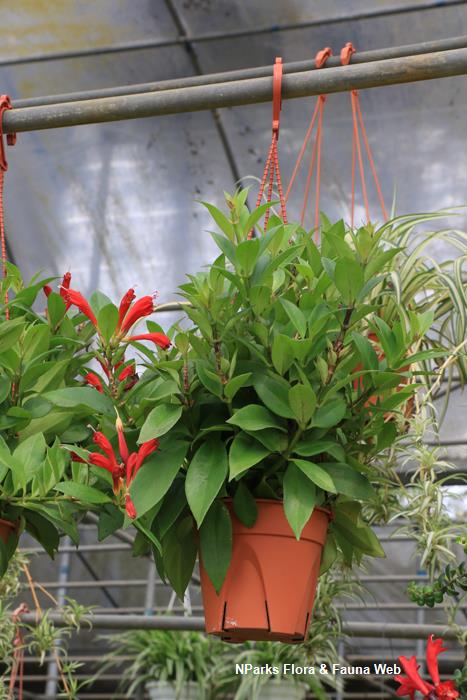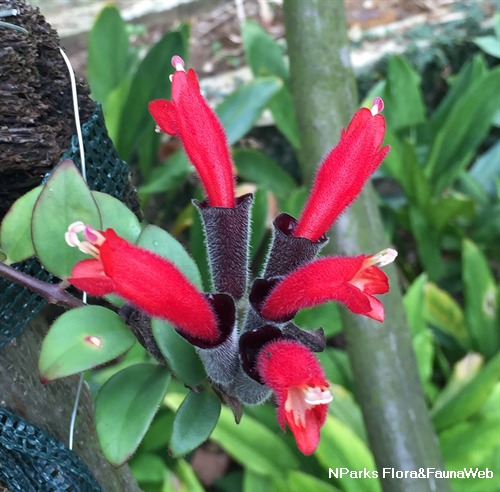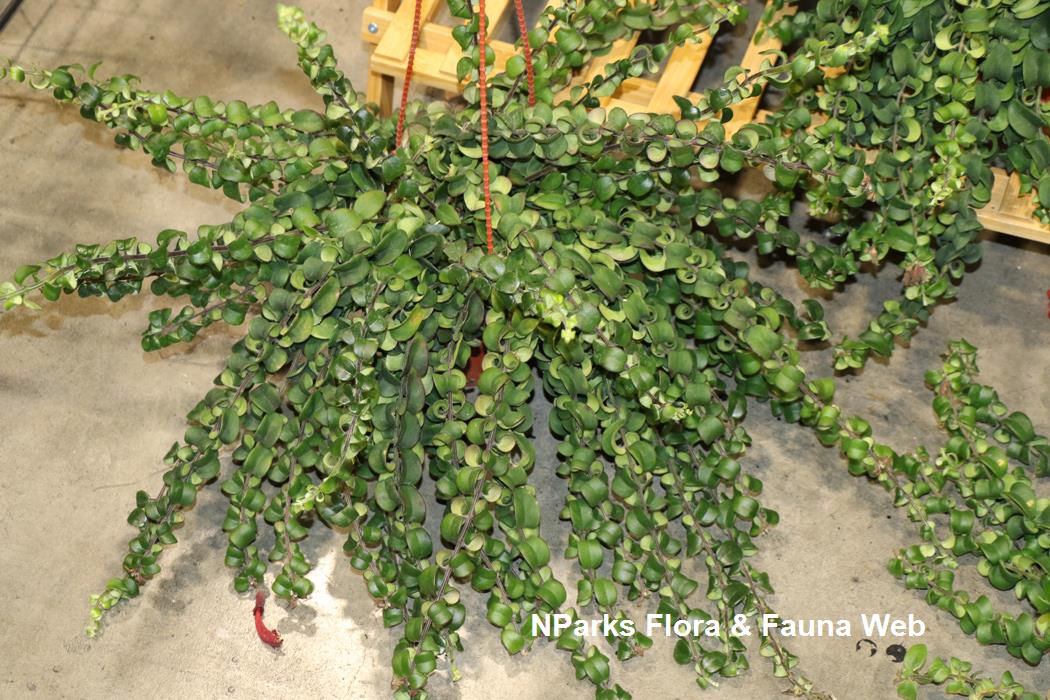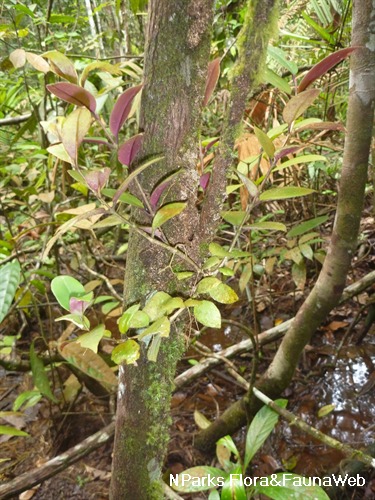.jpg)
Back
Aeschynanthus wallichii R.Br.
| Family Name: | Gesneriaceae |
Aeschynanthus wallichii is a critically endangered epiphyte native to Singapore. Clusters of bright red, velvety, tubular flowers at the ends of its long pendulous branches and attract nectar-feeding birds like sunbirds. It grows best in semi-shade conditions and is suitable for hanging baskets.
Name
Classifications and Characteristics
| Plant Division | Angiosperms (Flowering Seed Plants) (Dicotyledon) |
|---|---|
| Plant Growth Form | Epiphyte |
| Lifespan (in Singapore) | Perennial |
| Mode of Nutrition | Autotrophic |
| Plant Shape | Irregular |
| Maximum Height | 1 m |
| Maximum Plant Spread / Crown Width | 1 m |
Biogeography
| Native Distribution | Peninsular Malaysia, Singapore, Sumatra. |
|---|---|
| Native Habitat | Terrestrial (Freshwater Swamp Forest, Primary Rainforest) |
| Preferred Climate Zone | Tropical |
| Local Conservation Status | Native to Singapore (Critically Endangered (CR)) |
Description and Ethnobotany
| Growth Form | An epiphyte |
|---|---|
| Foliage | Oppositely arranged, petiole is 5 - 12 mm long and smooth. Leaves are thick and leathery, ovate to elliptic, measuring 3 - 10 long by 0.8 - 5 cm wide. Leaf blade has acuminate apex and cuneate to subcordate base, entire leaf edges, smooth on both surfaces. |
| Stems | Glabrous (smooth) stems. |
| Flowers | Inflorescences are located at the axils, bearing 3 - 6 flowers. Calyx is light green, fused into a wide open cup with semicircle lobes. Petals are about 2- 2.7 cm long, with its tube slightly curved bright or dark red on the outside, with upper lobes slightly oblong or orbicular, side lobes ovate or deltoid, lower lobe ovate or orbicular. |
| Fruit | Capsule, 1.8 to 3.7 cm long, about 4 mm wide. |
| Habitat | Found growing in lowland dipterocarp forest or in peat swamp forest at 0 - 760 m altitude. |
| Similar | It is similar to Aeschynanthus obconicus but the flowers and calyx of A.wallichii are smaller. The calyx is also green and more saucer-shaped compared to A.obconicus that is red and more cup-shaped. |
| Etymology | The genus Aeschynanthus means shame-flower, in reference to the curved corolla tube that suggests a bowed head. The species wallichii refers to Nathaniel (Nathan Wolff) Wallich (1786-1854), a Danish botanist and author, Curator of Calcutta Botanic Garden. |
Landscaping Features
| Landscaping | This species has clusters of bright or dark red, furry, tubular flowers ang grows well as epiphyte, suitable for hanging baskets. |
|---|---|
| Desirable Plant Features | Ornamental Flowers, Ornamental Foliage |
| Landscape Uses | Container Planting, Suitable for Hanging Baskets |
| Thematic Landscaping | Bird & Wildlife Garden |
Fauna, Pollination and Dispersal
| Fauna Pollination Dispersal Associated Fauna | Bird-Attracting (Flowers) |
|---|---|
| Pollination Method(s) | Biotic (Fauna) (Vertebrates (Bird)) |
| Seed or Spore Dispersal | Abiotic |
Plant Care and Propagation
| Light Preference | Semi-Shade |
|---|---|
| Water Preference | Moderate Water |
| Plant Growth Rate | Moderate |
| Propagation Method | Stem Cutting |
Foliar
| Foliage Retention | Evergreen |
|---|---|
| Mature Foliage Colour(s) | Green |
| Mature Foliage Texture(s) | Thick |
| Prominent Young Flush Colour(s) | Green - Light Green |
| Young Flush Texture(s) | Smooth |
| Foliar Type | Simple / Unifoliate |
| Foliar Arrangement Along Stem | Opposite |
| Foliar Attachment to Stem | Petiolate |
| Foliar Shape(s) | Non-Palm Foliage (Elliptical, Ovate) |
| Foliar Venation | Pinnate / Net |
| Foliar Margin | Entire |
| Foliar Apex - Tip | Acuminate |
| Foliar Base | Cuneate |
Non - Foliar and Storage
| Stem Type & Modification | Herbaceous, Woody |
|---|---|
| Root Type | Underground |
Floral (Angiosperm)
| Flower & Plant Sexuality | Bisexual Flowers |
| Flower Colour(s) | Red |
|---|---|
| Flower Texture(s) | Velvety / Furry / Tomentose |
| Flower Grouping | Cluster / Inflorescence |
| Flower Location | Axillary |
| Flower Symmetry | Bilateral |
| Individual Flower Shape | Tubular |
| Inflorescence Type | Umbel |
| Flowering Period | A Few Times Yearly |
| Flower Size | 2 cm |
Fruit, Seed and Spore
| Fruit Classification | Simple Fruit |
|---|---|
| Fruit Type | Dehiscent Dry Fruit , Capsule |
| Seed Description | grain of 0.8 - 1.2 mm by 0.2 - 0.3 mm, papillose |
Image Repository
Others
| Master ID | 34013 |
|---|---|
| Species ID | 8429 |
| Flora Disclaimer | The information in this website has been compiled from reliable sources, such as reference works on medicinal plants. It is not a substitute for medical advice or treatment and NParks does not purport to provide any medical advice. Readers should always consult his/her physician before using or consuming a plant for medicinal purposes. |

.jpg)
.jpg)
.jpg)



